|
In order not to seperate philately from its historical context, I have written concise introductions. These are not meant to be ideologically balanced portrayels and are not giving the various diveregent interpretations of events equal value.
The history of the Middle East is problably the most controversial field of historiography.
I may hold positions that do not necessarily concur with the dominant pro-zionist historiography, but there are enough websites that deal with the Arab-Israel conflict in general and also those that present the standpoints and views of all sides in the conflict.
Everyone interested in history has the possibility to chose and to form an opinion of his own.
|
The General Situation (1914--1949)
|
During the First World war the Ottoman Empire remained initially neutral. It was though allied to Germany by various (mainly anti-Russian) treaties.
Provoked by Russian actions in the Black Sea it declared War against Russia, Britain and France in November 1914.
Treaties between the allied powers (London 1914, Chantilly 1915, Sykes-Picot 1916) envisaged the partition of the Arab parts of the Ottoman Empire
|
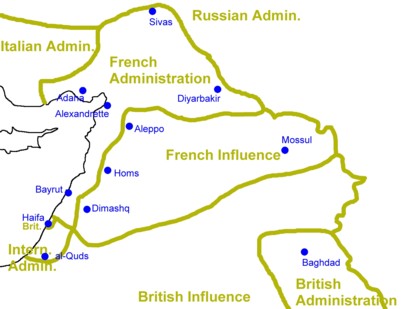
Secret partition plans, 1916 (Sykes-Picot)
|
|
|
In total contradiction to these plans, the Hussein-McMahon-Agreement of 1916 promises the leader of the Panarab movement Hussein Ibn Ali, Grand-Sherif of Mecca, the establishmenmt of an independent Arab state.
|
|
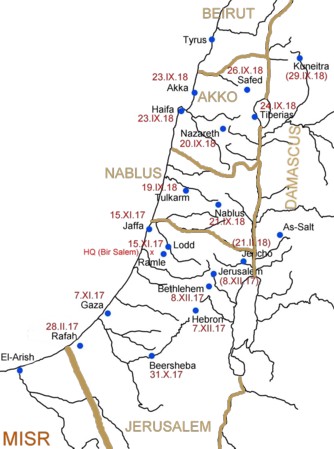
The advance of British and allied troops in Palestine, 1917-1918
|
In 1916 a Turkish advance on the Suez canal is thwarted. On the side of Turkey German troops participate.
At the beginning of 1917 British troops conquer and occupy Mesopotamia, starting in February also Palestine. Until December the Egyptian Expeditionary Force (E.E.F.) and allied troops reach (under the command of General Allenby) the line Jaffa-Jerusalem, in February 1918 Jericho-Ramallah, by September they occupy Acre (Akka).
In October 1918 Damascus is taken and the advance finally reaches Aleppo.
In parallel Arab troops under the leadership of Grand-Sherif Hussein Ibn Ali and with the help of British advisers (T.E. Lawrence, et al.) advance northwards on the East bank of the Jordan.
An Armistice is agreed on 30.10.1918. Troops in Palestine consist of British, Indian, Australian, New Zealand, French and Italian forces.
|
|
|
The San Remo conference (19-26.04.1920) and the treaties of Sèvres (10.08.1920) and Saint-Jean-de-Maurienne determine the break-up of the Ottoman Empire. Contrary to prior agreements with Arabian forces, occupied Arabia is partitioned according to the Sykes-Picot accord.
Great Britain is granted with Palestine (incl. Transjordan) and Iraq; France is given Syria (incl. Lebanon) und Cilicia. Originally Sykes-Picot intended an international status for (Northern) Palestine. These so called "A-Mandates" should have lead the Arab nation(s) to independence.
Following the conference of Cairo (1.04.1921), Transjordan is granted the status of Emirate and receives formal independence on 15.05.1922 (within the mandate). On 15.05.1923 Transjordan is formally separated from Palestine. This mandate ceased on 22.03.1946, however (Trans-) Jordan remains under effective British control until 1956.
A civil administration is established in Palestine by 1.07.1920. The first British High Commissioner is Sir Herbert Samuel. The League of Nations decrees on 24.07.1922 a mandate on Palestine, which sets in formally on 29.09.1922.
At the beginning of the 1930s and increasing number of European Jews immigrate to Palestine. They establish segregated, and often fortified, settlements and form paramilitary organisations.
A British plan to partition Palestine (Peel-Commission) fails in 1937. It envisages two states along settlement lines and an international zone (under British control) covering Jerusalem and Jaffa.
Tensions rise due to aggressions, leading to a civil-war-like situation from 1936. In 1947 Britain calls on the United Nations to solve the problem. A special commission (UN Special Commission On Palestine, UNSCOP) is instituted.
Their final report recommends the partition of Palestine into an Arab and a Jewish state along racial lines; Jerusalem should remain a neutral zone under UN control.
The general assembly of the United Nations accepts the UNSCOP plan in its meeting on 29.11.1947 and establishes a new supervising commission (UN Palestine Commission, UNPC).
Great Britain abdicates from her responsibilities and returns the mandate to the UN, completing the withdrawal of all her forces by 15.05.1948.
|
|

Partition-Plan, Peel-
Commission, 1937 |
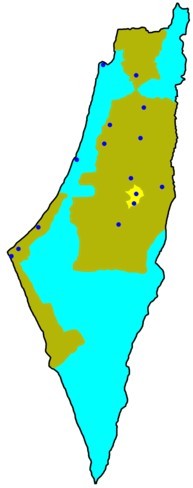
UN Partition-Plan
(UNSCOP), 1947 |
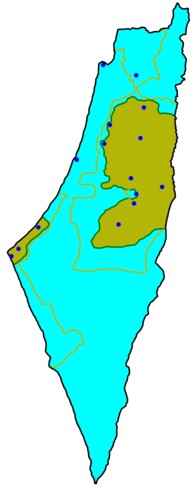
Ceasefire-Lines,
January 1949 |
|
|
On 14.05.1948 zionist settlers proclaim the state of Israel. Acts of terror during this period (e.g. massacre of Deir Yassin on 9.04.1948) provoke stampedes among civilians.
In order to protect the civilian population in Palestine independent Arab nations form the Arab Legion, consisting of troops from Egypt, Jordan, Syria, Lebanon and Iraq.
Attempts by the UN to mediate fail. The UN representative, Count Bernadotte, is murdered by zionist terrorists on 17.09.1948. His successor is Ralph Bunche. A cease-fire is finally reached on 7.01.1949.
The agreed cease-fire lines act as lines of demarcation between Jews and Arabs until 1967. The so called "Westbank" stays under Jordanian control, the "Gaza Strip" is occupied by Egypt.
|
|
|
Be notified of
page updates
|
|
I provide a listing of all changes to my pages. It also provides a free notification service by e-mail:
|
|
Log of Changes
|
|
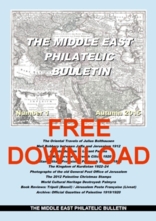
|
Back to the Introduction
Back to the Zobbel Homepage
[Created 7.07.2002, last revised 13.08.2005]
[www.zobbel.de – Dipl.-Bibl.(FH) Tobias Zywietz – all rights reserved]
Imprint/Impressum – Datenschutzerklärung/Privacy Policy
|





